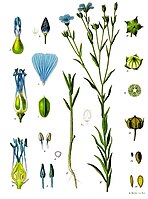
Photo from wikipedia
Plant biofibers are of great economic and commercial importance. Among various fiber producing crops, cotton ( Gossypium hirsutum L.), hemp ( Cannabis sativa L.), flax ( Linum usitatissimum L.), kenaf… Click to show full abstract
Plant biofibers are of great economic and commercial importance. Among various fiber producing crops, cotton ( Gossypium hirsutum L.), hemp ( Cannabis sativa L.), flax ( Linum usitatissimum L.), kenaf ( Hibiscus cannabinus L.), and jute ( Corchorus capsularis L.) are of prime importance. Fibers harvested from these crops are of fine quality and have a significant commercial value worldwide. Owing to multiple structural and functional roles of these fibers within plants, the mechanical properties vary to a considerable extent. In the present review, insights into the history, geographical distribution, and production of these crops on saline soils is discussed. The salinity stress tolerance of the fiber crops can be improved via improvement in free radical scavenging, upregulation of antioxidants, potassium retention, enhanced osmolyte synthesis, and accumulation and better ion partitioning. Biotechnological approaches to increase tolerance and fiber quality under salt-affected areas include development of transgenic fiber crops for Na + vacuolar sequestration and improvements in physio-biochemical attributes.
Journal Title: Journal of Plant Growth Regulation
Year Published: 2020
Link to full text (if available)
Share on Social Media: Sign Up to like & get
recommendations!